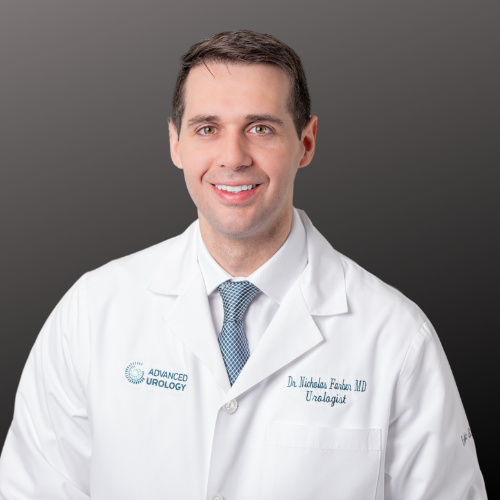

By Dr. Chirag Dave and Dr. Nicholas Farber, Advanced Urology
Prostate Cancer Survivorship Overview
About 240,000 men in the United States are diagnosed with prostate cancer every year; the most common age at diagnosis is 67 years. With appropriate treatment, over 90% of men will still be living with their prostate cancer 15 years out from their diagnosis. The treatment recommendations for your prostate cancer may vary based on your age, medical health, and the likelihood that your cancer will progress. Based on how severe your disease is, management may include active surveillance, or you may receive radical prostatectomy surgery and/or radiation therapy. Some patients may receive androgen deprivation therapy as well.
Since most prostate cancer survivors have other medical conditions and most prostate cancers are slow growing, only about 2-15% of men die as a result of their underlying prostate cancer. As such, if you have a less aggressive disease biology and/or a shorter life expectancy, management of your cancer may simply involve active monitoring of your cancer to avoid or delay treatment and its potential side effects. Monitoring may include routine PSA testing, digital rectal exams, prostate biopsies, and MRI imaging. If additional treatment is indicated:
- Men aged 65 years and younger: 57% will get a radical prostatectomy surgery and 25% will receive radiation
- Men aged 65-74: 42% will get radiation and only 33% will get a radical prostatectomy surgery
Prostate Cancer Primary Treatment Patterns by Age, 2008. Siegel R, DeSantis C, Virgo K, et al. Cancer treatment and survivorship statistics, 2012. CA Cancer J Clin. 2012;62:220‐241
Regardless of the management option utilized for your prostate cancer, prostate cancer survivorship remains an important part of your recovery. Our prostate cancer survivorship program focuses on the following:
- To monitor you closely for disease reoccurrence.
- To educate you and promote lifestyle changes which can help hasten your recovery (i.e., maintain a healthy weight, increase physical activity, adjust and improve your diet, and stop smoking).
- To evaluate and treat any adverse effects which may be causing you physical, psychological, or relationship distress.
For example, many prostate cancer survivors experience long‐term and late effects of the disease. This may include, but is not limited to, treatment-related urinary incontinence, sexual dysfunction, and bowel issues, as well as adverse psychosocial and relationship effects. Some long‐term and late effects may even be exacerbated by some of your other health conditions. Accordingly, 20% of patients suffer from feelings of loss or distress over a decision made under uncertain conditions. This treatment‐related regret is most often influenced by the presence of adverse effects from treatment such as urinary and sexual functioning.
Screening for Prostate Cancer Recurrence
There is no consensus on how often PSA levels should be monitored to detect prostate cancer recurrence after treatment, or how best to follow men on active surveillance. The NCCN guidelines for prostate cancer treatment recommend measuring serum PSA levels every 6 to 12 months for the first 5 years after definitive treatment, and then to recheck PSA annually.
- If you had radical prostatectomy, you can usually expect your PSA to drop to an undetectable level (less than 0.03 ng/mL) within a 2‐month period.
- If you received radiation therapy, you can expect your PSA to fall slower and generally reach its lowest level ("PSA nadir") after 6 months to several years. A "PSA bounce" may occur, usually within 2 years, in which the PSA level begins to rise and then comes back down. This can be considered normal, however, any rise in your PSA should be reported to your Urologist.
- If you were treated with androgen deprivation therapy (ADT), your rate of PSA decline and nadir may vary compared to other men who also received ADT. The overarching goal should be to achieve a PSA level less than 0.05 or 0.1 ng/mL. A decline should be seen within 6 to 8 weeks following therapy initiation, but your rate of decline will depend on your PSA level at the time of ADT initiation (for example, a higher PSA level at therapy initiation will take a longer time to decline).
Preventative Measures for Prostate Cancer Recurrence
1. Maintain A Healthy Weight
Obesity is directly linked to worse health outcomes related to your prostate cancer. This includes survival and reoccurrence of your disease after treatment. If you are a survivor who is overweight or obese, it is important to limit your consumption of high‐calorie foods and beverages as well as to increase weight loss activities to help maintain a healthy weight and improve health outcomes.
2. Increase Physical Activity
Studies suggest that physical activity may decrease the likelihood of your prostate cancer returning, improve your overall survival after prostate cancer treatment, and help to hasten your recovery from the treatment itself.
· The ACS guidelines recommend at least 150 minutes of moderate‐intensity exercise per week or 75 minutes vigorous‐intensity aerobic physical activity per week. Research has shown that 3 or more hours per week of vigorous activity among prostate cancer survivors is associated with a 61% reduction in death directly related to your prostate cancer.
Increasing physical activity has additional benefits as well. Exercising can help improve your overall health and physical functioning (i.e., it can help reduce your risk of heart disease and improve fatigue, anxiety, depressive symptom management, self‐esteem, happiness, and quality of life).
3. Adjust your Nutrition Intake
Findings suggest that diets high in vegetables, fruits, and whole grains improve prostate cancer survival and may also reduce the risk of developing a second cancer and chronic diseases.
If you are a prostate cancer survivor, you should consider lifestyle changes that include:
o a diet which contains micronutrient‐rich and phytochemical‐rich vegetables and fruits and low amounts of saturated fat.
o limiting alcohol consumption to no more than 2 drinks per day.
o at least 600 IU of Vitamin D per day and an adequate, but not excessive amount of dietary sources of calcium (not to exceed 1200 mg/day) (this is especially important if you are a survivor receiving ADT due to its increased risk of bone breakdown/osteoporosis and bone fractures).
4. Stop Smoking
Smoking after treatment for prostate cancer increases the risk of your cancer coming back and the risk that you may develop a second cancer. If you are a smoker, it is important to talk to your primary care doctor about options to help with smoking cessation.
Monitoring for Physical and Psychologic Effects of Prostate Cancer Treatment
After your prostate cancer treatment, you will meet with both your oncologic surgeon as well as a quality of life specialty Urologist to closely monitor for recurrence of your cancer as well as post-treatment effects. Your quality of life Urologist will assess for both physical and psychosocial effects of prostate cancer and its treatment. The focus of assessment will be tailored to the type of cancer treatment you received and your current disease state. Some of the post-treatment effects which are monitored include:
- Anemia:
Thinning of your blood is a common complication of Androgen Deprivation Therapy. A yearly CBC should be checked by either your primary care provider or your Urologist if you are on Androgen Deprivation Therapy.
- Cardiovascular Disease:
There is varying data that if you are on ADT for prostate cancer, you may have an increased risk of heart disease related death. If you notice difficulty breathing and chest pain, you should report it to your primary care provider or your cardiologist as you may need closer evaluation.
- Fracture Risk/Osteoporosis:
If you are on ADT, you are at an increased risk for bone loss and bone fractures. If you have had radiation for your prostate cancer, your risk of hip fracture further increases. Your bone density will be monitored with a DEXA scan. You may be prescribed a calcium and vitamin D supplement, and, if indicated, a bisphosphonate, to increase your bone density and reduce your risk for bone fractures.
- Bowel Issues:
If you were treated with radiation for your prostate cancer, you may experience cramps, diarrhea, bowel irregularity, and stool leakage (fecal incontinence) due to its effects on the wall of your bowel. You may also see blood in your stool, especially if you take aspirin or blood thinners. Most symptoms can be treated with stool softeners, topical steroids, or anti-inflammatory medications. Persistent and substantial bleeding might require careful evaluation by a gastroenterologist or colorectal surgeon. If you have persistent stool leakage or stool urgency, please discuss this with your Urologist, as you may benefit from a test to see if you are a candidate for a spinal nerve stimulator.
- Psychologic Distress or Anxiety:
Studies indicate that as many as 30% of patients with prostate cancer experience general distress, 25% have increased anxiety, and 20% experience depression. This distress may be the result of anxiety from the knowledge of the prostate cancer and routine PSA testing or from the treatment-related adverse effects. You should work with your quality of life Urologist and your PCP, who may have options to help treat and overcome may of the post-treatment related adverse effects. If you have thoughts of harming yourself or others, you should immediately let your primary care provider or your urologist know.
- Erectile/Sexual Dysfunction:
Biological and psychosocial aspects of sexual function are impacted by prostate cancer treatment. If you are of older age, have preexisting erectile dysfunction (ED), or did not undergo nerve-sparing surgery because of advanced disease, you are at the highest risk for poor recovery in your erectile function after surgery. Radiation treatment can also hinder your erections in a similar manner. Some men may not return to their prior level of sexual function after their prostate cancer treatment without additional medical or surgical care, and it may take as long as 2 years to fully regain your erectile function after prostate cancer treatment. In efforts to expedite your recovery, we recommend early penile rehabilitation after prostate cancer surgery which may improve penile blood flow, reduce atrophy of the penis muscles, and decrease penile damage from to neurovascular injury and scarring.
Our penile rehabilitation treatment involves:
- Routine meetings with a quality of life Urologist. Your sexual function will be routinely monitored by a sexual function survey called a SHIM score, which you will be asked to fill out prior to each visit with your Quality of Life Urologist.
- Early treatment with a long acting phosphodiesterase type 5 (PDE‐5) inhibitor to improve penile blood flow and oxygenation.
- Early use of a vacuum erection device to limit penile shortening and strengthen your penile muscles (reduce corporal atrophy and fibrosis).
- Early evaluation of your erectile function with a penile ultrasound to assess if you would benefit from additional treatment options such as intracavernosal injection therapy or a penile implant.
Low testosterone can cause a decrease in your sex drive and oftentimes affect your erections. Testosterone therapy for men on active surveillance or who have a history of prostate cancer is controversial and this should be further discussed with your quality of life specialist. Men on ADT, a treatment that significantly lowers your testosterone, cannot have testosterone therapy, but may benefit from PDE-5 inhibitor therapy or other treatment options such as intracavernosal injection therapy or penile implant surgery to treat their erectile dysfunction.
Patients and partners need support in recovery of their sexual relationships. Men's ED affects partners and couples' intimate relationships. Additional treatment effects can interfere with the couple's recovery of sexual intimacy, such as urinary incontinence after surgery; bowel and urinary irritation after radiation; and hot flushes, weight gain, loss of libido, and irritability due to hormonal deprivation. We strongly recommend the patient and his partner come to visits with their Quality of Life Urologist to discuss interventions to enhance couples' emotional intimacy and sexual function.
- Urinary dysfunction: There are two types of incontinence that you may experience after treatment for prostate cancer.
- Stress incontinence, or post-prostatectomy incontinence, is urinary leaking with coughing, sneezing, standing, or sexual intercourse (climacturia). This type of incontinence tends to improve gradually after surgery and generally remain stable after one year. Kegel exercises or pelvic floor therapy may expedite your urinary control.
- Men with stress incontinence refractory to pelvic floor therapy may benefit from incontinence surgery. There are several treatment options for that.
Slings
: There are different slings available to provide the support under the urethra to prevent leakage of the urine. This is usually an outpatient procedure and patient can go home the same day and is best for men who require two or less pads per day or have leakage only during sex (climacturia).
Artificial urinary sphincter
: This procedure is for men who have severe stress incontinence who soak 3 or more pads per day. There is a cuff which is placed around the urethra which keeps the urethra closed all the time. It also has a pressure regulated balloon and a small pump which is placed inside the scrotum. When one wants to urinate he simply presses the pump and the sphincter opens up leading to normal urination and then it closed back up automatically. This has been around for more than 30 years and is a very effective treatment for stress incontinence in men.
Mini Male Sling / Mini Jupette Sling
: For men with primarily incontinence during sexual intercourse (climacturia) who will be undergoing an inflatable penile prosthesis (IPP) for erectile dysfunction, they may benefit from a mini-sling that can be placed at the same time as their IPP. This sling tightens when the IPP is inflated, decreasing or eliminating leakage during sex.
- Urge incontinence, is more commonly a side effect of radiation therapy on the urinary tract include irritative and/or obstructive symptoms presumed to be from irritation or swelling of the bladder or prostate. The long term effects of radiation can result urinary stricture, urinary incontinence, overactive bladder, fistula, hematuria presumed secondary to telangiectasias or mucosal thinning, decreased bladder capacity, slowing of the urinary stream, nocturia, and urinary retention.
- This form of incontinence is better treated with muscle relation pelvic floor therapy and muscle relaxing medications such as anti-cholinergic or beta-3 agonist medications.
- If you have persistent urge incontinence or frequency or urgency that is not improving with conservative options listed above, you may need additional testing that may include cystoscopy, urodynamics, or a peripheral nerve evaluation to see if you might benefit from minor surgical procedures such as a direct vision urethrotomy, urolift, spinal nerve stimulator or botox therapy. These options should be discussed with your quality of life Urologist.
- Urge incontinence, is more commonly a side effect of radiation therapy on the urinary tract include irritative and/or obstructive symptoms presumed to be from irritation or swelling of the bladder or prostate. The long term effects of radiation can result urinary stricture, urinary incontinence, overactive bladder, fistula, hematuria presumed secondary to telangiectasias or mucosal thinning, decreased bladder capacity, slowing of the urinary stream, nocturia, and urinary retention.
When to Enroll in the Prostate Cancer Survivorship Program?
Prostate Cancer Survivorship is a program intended to address quality of life issues that you may be experiencing since your diagnosis with prostate cancer. It simply involves meeting with a Quality of Life Urologist with the intention of specifically addressing these issues. It is recommended you consult one of our specialty trained Urologists if you are experiencing any of the following:
- Anxiety over repeated PSA monitoring
- Worsened erectile dysfunction since your diagnosis
- A decline in the intimacy between you and your partner since the diagnosis
- Urinary leakage when you cough or sneeze
- Overactive bladder causing you to wake up at night or go frequently during the daytime
- Urinary urgency with or without urinary leakage
- Fecal (stool) urgency with or without stool leakage
- Depression from any of the above adverse effects of treatment
A Quality of Life Urologist may prescribe you with oral or injectable medication or suggest minor surgical treatment options that could permanently correct the issue at hand. Most surgeries that are intended to improve your quality of life are relatively simple and have a diagnostic test that can confirm that you will benefit from it. You can expect to be home from the hospital in bed that day.
At this point, you've probably researched your symptoms online and come to a conclusion about your condition. Maybe you've entered queries like "where to get help after prostate cancer" or "urologist near me." If this is you, Advanced Urology in Atlanta is here for you. Call Advanced Urology today to learn more about treatment options and make an appointment.

